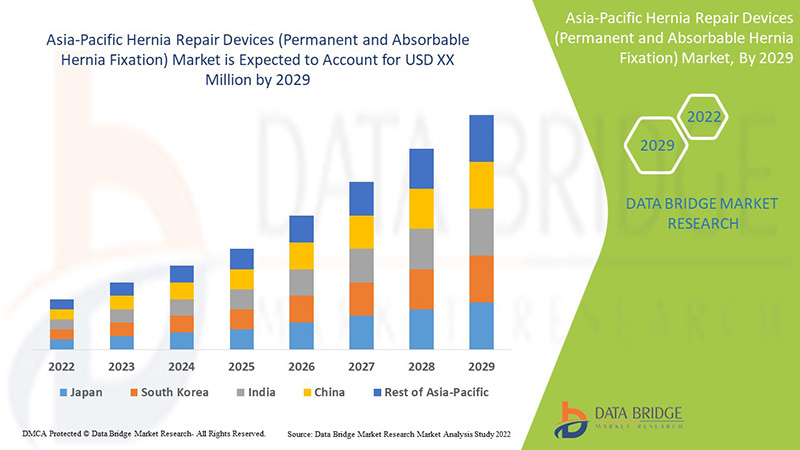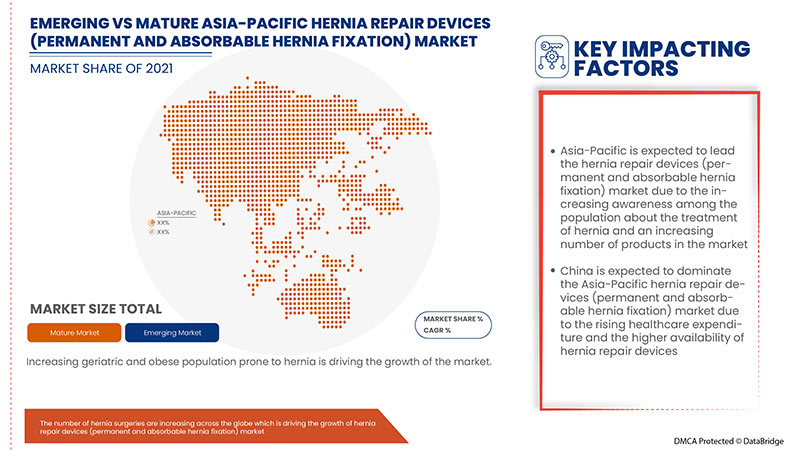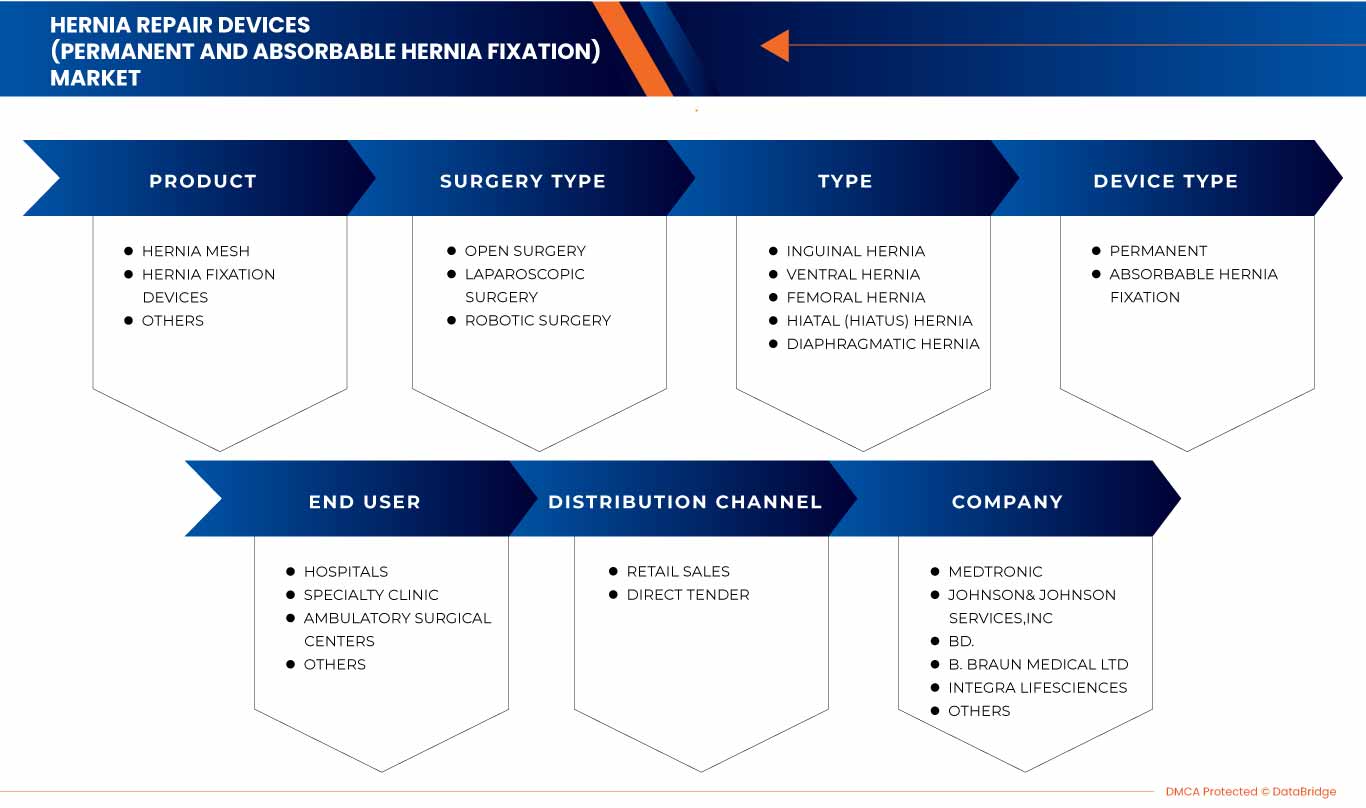Asia-Pacific Hernia Repair Devices (Permanent And Absorbable Hernia Fixation) Market, By Type (Inguinal Hernia, Femoral Hernia, Umbilical Hernia, Hiatal (Hiatus) Hernia, Incisional Hernia, Epigastric Hernia, Spigelian Hernia, Diaphragmatic Hernia), End-User (Hospitals, Specialty Clinics, Ambulatory Centers, Others), Distribution Channel (Direct Tender, Retail Sales), Industry Trends and Forecast to 2029
Market Analysis and Insights

Hernia repair surgery is one of the most common surgeries to be performed. There are mainly two main types of surgeries open surgery and laparoscopic surgery. In open surgery, the surgeon makes a cut in the groin to view and repair the hernia. After repairing the hernia, the surgeon uses stitches alone or stitches and a piece of mesh to close the abdominal wall. The mesh is designed to strengthen the weak area of the abdominal wall where the hernia occurred. Laparoscopic hernia repair was introduced in the early nineties as a minimally invasive alternative to the classic Lichtenstein repair (Open Surgery). The surgeon makes several small cuts in the lower abdomen and inserts special tools to view and repair the hernia. The surgeon typically uses a piece of mesh to close and strengthen the abdominal wall.

Asia-Pacific hernia repair devices (permanent and absorbable hernia fixation) market report provides details of market share, new developments, the impact of domestic and localized market players, analyses opportunities in terms of emerging revenue pockets, changes in market regulations, product approvals, strategic decisions, product launches, geographic expansions, and technological innovations in the market. Contact us for an analyst brief to understand the analysis and the market scenario. Our team will help you create a revenue impact solution to achieve your desired goal. Strategic initiatives such as collaboration, agreement, and signing of sales agreements to invent and innovate pharmacological treatments are the major drivers that propelled the market's demand in the forecast period.
Asia-Pacific hernia repair devices (permanent and absorbable hernia fixation) market is supportive and aims to reduce the progression of the disease. Data Bridge Market Research analyses that the Asia-Pacific hernia repair devices (permanent and absorbable hernia fixation) market will grow at a CAGR of 7.6% during the forecast period of 2022 to 2029.
|
Report Metric |
Details |
|
Forecast Period |
2022 to 2029 |
|
Base Year |
2021 |
|
Historic Years |
2020 (Customizable to 2019 - 2014) |
|
Quantitative Units |
Revenue in USD Million, Pricing in USD |
|
Segments Covered |
By Type (Inguinal Hernia, Femoral Hernia, Umbilical Hernia, Hiatal (Hiatus) Hernia, Incisional Hernia, Epigastric Hernia, Spigelian Hernia, Diaphragmatic Hernia), End-User (Hospitals, Specialty Clinics, Ambulatory Surgical Centers, Others), Distribution Channel (Direct Tender, Retail Sales) |
|
Countries Covered |
Japan, China, India, Australia, Singapore, South Korea, Malaysia, Thailand, Indonesia, Philippines, Rest of the Asia-Pacific |
|
Market Players Covered |
Medtronic, BD, Cook Group, Inc., W. L. Gore & Associates, Inc., ETHICON (A subsidiary of Johnson & Johnson Services, Inc.), Vivostat A/S, Baxter, Cooper Surgical Inc. (A Division of The Cooper Companies Inc.), Betatech Medical, pfm medical ag, B. Braun Melsungen AG, Integra LifeSciences, AbbVie Inc., BIOSISHEALING, Herniamesh S.r.L., Dipromed Srl, Meril Life Sciences Pvt. Ltd., among others. |
Market Definition
Hernia is a physiological problem where any tissue or organ pierces through a weakness or opening in the cavity wall where it usually resides. A very common example is the intestine coming out through the weak peritoneum of the abdominal wall, which is detected as a pouch under the skin. The cause of hernia is associated with the weak cavity wall tissue, which might be influenced by several risk factors, including obesity, intra-abdominal pressure, and previous abdominal surgeries.
Hernia may be of different types depending on its location in the human body. It can appear in an inguinal cavity, umbilicus, femoral canal, and epigastrium. Hernia usually makes a visible bulge on the skin, inducing pain and complications in patients. Primarily, the grown hernia induces discomfort and sometimes severe pain in the area. This pain intensifies during bowel movements, urination, or heavy physical labor. The protruded intestine may also be strangulated and hamper blood circulation if the protruded tissue gets swelled. Later on, this may lead to infection, necrosis, and life-threatening complications.
Asia-Pacific Hernia Repair Devices (Permanent and Absorbable Hernia Fixation) Market Dynamics
Drivers
- Increasing incidence of hernia
The condition of hernia requires treatment approaches, including medication and surgery. A hernia occurs when an internal part of the body pushes through a weakness in the muscle or surrounding tissue wall. The demand for hernia repair devices is high due to the increased prevalence of hernia types such as inguinal hernia and femoral hernia, which is expected to drive market growth. Inguinal hernia repair is one of the essential surgical procedures prioritized by the World Health Organization (WHO). It is also one of the most common surgical conditions worldwide, affecting 220 million people. Over 40,000 people die from complications from inguinal hernias, and about 3,500,000 disability-adjusted life years (DALYs) are lost annually.
- Increase in the obese population
The management of obese patients has become the forefront of hernia treatment with the rising number of obese patients and incidence of hernia. Being obese or overweight increases the strain and pressure on the abdominal muscles, making them weaker and more prone to developing hernias. Also, the risk of developing recurrent hernias is high if patients have poor adherence to recommended lifestyle modifications and factors such as being continuously obese and lifting heavy objects after surgical treatment to repair hernias. Hernia recurrence is more likely to occur especially umbilical hernias, in obese patients, both in male and female populations.
Opportunity
- Increase in minimal invasive surgery procedure
Minimally invasive surgery is associated with less pain, a shorter hospital stay, and fewer complications, increasing its demand in the market. Hernia minimal invasive surgeries are growing in the market with the increase in demand for minimally invasive techniques and their benefits to the patients compared to the traditional open surgeries, which pose risks of wound infection, among others. A rise in new technological advancements and demand for minimally-invasive surgical procedures has increased the use of surgical devices, which has risen the market growth and is expected to provide an opportunity for the market.
Restraints/Challenges
- Long Waiting Lines
Many public healthcare systems with universal health coverage use waiting lists as a rationing capacity to balance demand and access to more equitable services. Long delays, however, can have widespread negative consequences and threaten the principles of equity and providing timely access to care. In publicly funded health systems, waiting lists include the provision of a wide range of services, such as medical consultations, specialized care, diagnostic studies, or therapeutic procedures. Currently, the management of abdominal wall surgery waiting lists is carried out according to the length of time on the list and the priority in days (preferential 90 days, medium 180 days, and low 365 days) according to criteria related to the patient's clinical features and social conditions, risks associated with delayed surgery, and clinical effectiveness.
Concerns about the efficacy and safety of products used in hernia repair have caused most governments to develop regulatory agencies and policies to look after new medical devices. The use of medical devices can be done after passing stringent regulatory standards, which ensure the devices are safe, well-studied, and has no adverse reactions. The recent guidelines and the amendment have adequate guidance for manufacturers. International regulations such as medical device approvals play a major role in the new launch of hernia repair devices into the market. Thus, it can be a major restraint on the market growth of the Asia-Pacific hernia repair devices (permanent and absorbable hernia fixation) market.
Recent Developments
- In June 2021, BG Medical., the manufacturer and distributor of the 21st Century SURGIMESH Platform, announced it was honoring Hernia Awareness Month by partnering with CQInsights to pioneer a new approach that delivers better outcomes for patients, with a larger mission to share sustainable solutions that improve healthcare for everyone.
- In July 2021, BD (Becton, Dickinson and Company) announced it had acquired Tepha, Inc., a leading developer and manufacturer of proprietary resorbable polymer technology. The acquisition of Tepha provides strategic vertical integration of an important supply chain component for BD's existing Phasix Mesh products. Tepha's GalaFLEX portfolio, also based on the novel P4HB polymer, is included in the acquisition.
Asia-Pacific Hernia Repair Devices (Permanent and Absorbable Hernia Fixation) Market
Asia-Pacific hernia repair devices (permanent and absorbable hernia fixation) market is categorized into three notable segments: type, distribution channel and end-user. The growth among segments helps you analyze niche pockets of growth and strategies to approach the market and determine your core application areas and the difference in your target markets.
Type
- Inguinal Hernia
- Hiatal (Hiatus) Hernia
- Femoral Hernia
- Umbilical Hernia
- Incisional Hernia
- Epigastric Hernia
- Spigelian Hernia
- Diaphragmatic Hernia
On the basis of type, the Asia Pacific hernia repair devices (permanent and absorbable hernia fixation) market is segmented into the inguinal hernia, femoral hernia, umbilical hernia, hiatal (hiatus) hernia, incisional hernia, epigastric hernia, spigelian hernia and diaphragmatic hernia.
End-User
- Hospital
- Specialty Center
- Ambulatory Centers
- Others
On the basis of end-user, the Asia-Pacific hernia repair devices (permanent and absorbable hernia fixation) market is segmented into hospitals, specialty clinics, ambulatory centers, and others.
Distribution Channel
- Retail Sales
- Direct Tender

On the basis of distribution channel, the Asia-Pacific hernia repair devices (permanent and absorbable hernia fixation) market is segmented into direct tender and retail sales.
Asia-Pacific Hernia Repair Devices (Permanent and Absorbable Hernia Fixation) Market Regional Analysis/Insights
Asia-Pacific hernia repair devices (permanent and absorbable hernia fixation) market is analyzed, and market size insights and trends are provided by type, distribution channel and end-user, as referenced above.
The regions covered in the Asia-Pacific hernia repair devices (permanent and absorbable hernia fixation) market report are China, Japan, India, South Korea, Singapore, Malaysia, Australia, Thailand, Indonesia, Philippines, Rest of Asia-Pacific (APAC) in the Asia-Pacific (APAC). China is expected to dominate the Asia-Pacific market due to the increased geriatric population in the country and the increasing number of hernia repair surgeries.
The country section of the report also provides individual market impacting factors and changes in market regulation that impact the current and future trends of the market. Data points such as downstream and upstream value chain analysis, technological trends, porter's five forces analysis, and case studies are some of the pointers used to forecast the market scenario for individual countries. Also, the presence and availability of Asia-Pacific brands and their challenges faced due to large or scarce competition from local and domestic brands, the impact of domestic tariffs and trade routes are considered while providing forecast analysis of the country data.
Competitive Landscape and Asia-Pacific Hernia Repair Devices (Permanent and Absorbable Hernia Fixation) Market Share Analysis
Asia-Pacific hernia repair devices (permanent and absorbable hernia fixation) market competitive landscape provides details of the competitors. Details included are company overview, company financials, revenue generated, market potential, investment in research and development, new market initiatives, Asia-Pacific presence, production sites and facilities, production capacities, company strengths and weaknesses, product launch, product width and breadth, and application dominance. The above data points provided are only related to the companies' focus on the market of hernia repair devices (permanent and absorbable hernia fixation).
Some of the major players operating in the Asia-Pacific hernia repair devices (permanent and absorbable hernia fixation) market are Medtronic, BD, Cook Group, Inc., W. L. Gore & Associates, Inc., ETHICON (A subsidiary of Johnson & Johnson Services, Inc.), Vivostat A/S, Baxter, Cooper Surgical Inc. (A Division of The Cooper Companies Inc.), Betatech Medical, pfm medical ag, B. Braun Melsungen AG, Integra LifeSciences, AbbVie Inc., BIOSISHEALING, Herniamesh S.r.L., Dipromed Srl, Meril Life Sciences Pvt. Ltd., among others.
Research Methodology
Data collection and base year analysis are done using data collection modules with large sample sizes. The market data is analyzed and estimated using market statistical and coherent models. In addition, market share analysis and key trend analysis are the major success factors in the market report. The key research methodology used by the DBMR research team is data triangulation which involves data mining, analysis of the impact of data variables on the market, and primary (industry expert) validation. Apart from this, data models include Vendor Positioning grids, Market Time Line Analysis, Market Overview and Guide, Company Positioning Grid, Company Market Share Analysis, Standards of Measurement, Asia-Pacific Vs Regional and Vendor Share Analysis. Please request an analyst call in case of further inquiry.
SKU-
Get online access to the report on the World's First Market Intelligence Cloud
- Interactive Data Analysis Dashboard
- Company Analysis Dashboard for high growth potential opportunities
- Research Analyst Access for customization & queries
- Competitor Analysis with Interactive dashboard
- Latest News, Updates & Trend analysis
- Harness the Power of Benchmark Analysis for Comprehensive Competitor Tracking
Research Methodology
Data collection and base year analysis are done using data collection modules with large sample sizes. The stage includes obtaining market information or related data through various sources and strategies. It includes examining and planning all the data acquired from the past in advance. It likewise envelops the examination of information inconsistencies seen across different information sources. The market data is analysed and estimated using market statistical and coherent models. Also, market share analysis and key trend analysis are the major success factors in the market report. To know more, please request an analyst call or drop down your inquiry.
The key research methodology used by DBMR research team is data triangulation which involves data mining, analysis of the impact of data variables on the market and primary (industry expert) validation. Data models include Vendor Positioning Grid, Market Time Line Analysis, Market Overview and Guide, Company Positioning Grid, Patent Analysis, Pricing Analysis, Company Market Share Analysis, Standards of Measurement, Global versus Regional and Vendor Share Analysis. To know more about the research methodology, drop in an inquiry to speak to our industry experts.
Customization Available
Data Bridge Market Research is a leader in advanced formative research. We take pride in servicing our existing and new customers with data and analysis that match and suits their goal. The report can be customized to include price trend analysis of target brands understanding the market for additional countries (ask for the list of countries), clinical trial results data, literature review, refurbished market and product base analysis. Market analysis of target competitors can be analyzed from technology-based analysis to market portfolio strategies. We can add as many competitors that you require data about in the format and data style you are looking for. Our team of analysts can also provide you data in crude raw excel files pivot tables (Fact book) or can assist you in creating presentations from the data sets available in the report.













